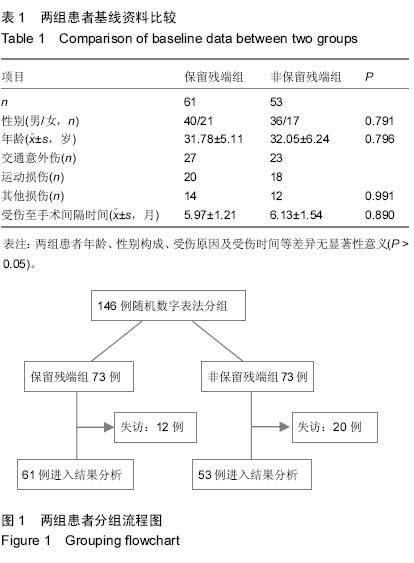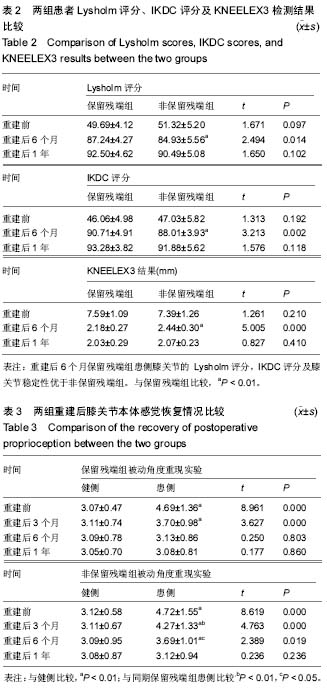| [1] Chambat P, Guier C, Sonnery-Cottet B, et al.The evolution of ACL reconstruction over the last fifty years. Int Orthop.2013; 37(2):181-186.
[2] Papalia R,Maffulli N, Denaro V.The anterior cruciate ligament remnant: to leave it or not? Arthroscopy.2013;29(11):1736-1737.
[3] Middleton KK, Hamilton T, Irrgang JJ, et al. Anatomic anterior cruciate ligament (ACL) reconstruction: a global perspective. Part 1. Knee Surg Sports Traumatol Arthrosc.2014;22(7): 1467-1482.
[4] Lysholm J, Gillquist J. Evaluation of knee ligament surgery results with special emphasis on use of a scoring scale.Am J Sports Med. 1982;10(3):150-4.
[5] Irrgang JJ, Anderson AF, Boland AL, et al. Development and validation of the international knee documentation committee subjective knee form. Am J Sports Med. 2001;29(3):600-613.
[6] Dhillon MS, Bali K, Vasistha RK.Immunohistological evaluation of proprioceptive potential of the residual stump of injured anterior cruciate ligaments (ACL).Int Orthop.2010; 34(5): 737-741.
[7] Nakase J, Toratani T, Kosaka M,et al. Roles of ACL remnants in knee stability. Knee Surg Sports Traumatol Arthrosc.2013; 21(9):2101-2106.
[8] Bali K, Dhillon MS, Vasistha RK,et al. Efficacy of immunohistological methods in detecting functionally viable mechanoreceptors in the remnant stumps of injured anterior cruciate ligaments and its clinical importance.Knee Surg Sports Traumatol Arthrosc.2012;20(1):75-80.
[9] Adachi N, Ochi M, Uchio Y, et al.Anterior cruciate ligament augmentation under arthroscopy. A minimum 2-year follow-up in 40 patients. Arch Orthop Trauma Surg 2000;120:128-133.
[10] Lee BI,Kwon SW,Kim JB,et al.Comparison of clincal results according to amount of preserved remnant in arthroscopic anterior cruciate ligement reconstruction using quadrupled hamstring graft.Arthroscopy.2008;24(5):560-568.
[11] Kim SJ, Jo SB, Kim TW,et al. A modified arthroscopic anterior cruciate ligament double-bundle reconstruction technique with autogenous quadriceps tendon graft: remnant-preserving technique. Arch Orthop Trauma Surg.2009;129(3):403-407.
[12] Gohil S,Annear PO, Breidahl W. Anterior cruciate ligement reconstruction using autologous double hamstings:a comparison of standard versusminimal debridement techniques using MRI to assess revascularisation.A randomised prospective study with a one-year follow-up.J Bone Joint Surg Br.2007;89(9):1165-1171.
[13] 孙磊,吴波,田敏,等.保留与切除残疾ACL重建移植物形态学比较[J].中国运动医学杂志,2012,31(7),577-582.
[14] Kim MK, Lee SR, Ha JK,et al.Comparison of second-look arthroscopic findings and clinical results according to the amount of preservedremnant in anteriorcruciate ligament reconstruction.Knee. 2014;21(3):774-778.
[15] Zhang Q1, Zhang S, Cao X et al The effect of remnant preservation on tibial tunnel enlargement in ACL reconstruction with hamstring autograft: a prospectiverandomized controlled trial. Knee Surg Sports Traumatol Arthrosc.2014;22(1):166-173.
[16] Bonfim TR,Jansen Paccola CA,Barela JA.Proprioceptive and behavior impairments in individuals with anterior cruciate ligament reconstructed knees.Arch Phys Med Rehabil.2003; 84(8):1217-1223.
[17] Junkin DM Jr, Johnson DL.ACL tibial remnant, to save or not?vOrthopedics.2008;31(2):154-159.
[18] Ahn JH, Wang JH, Lee YS, et al Anterior cruciate ligament reconstruction using remnant preservation and a femoral tensioning technique: clinical and magnetic resonance imaging results. Arthroscopy.2011;27(8):1079-1089. |

